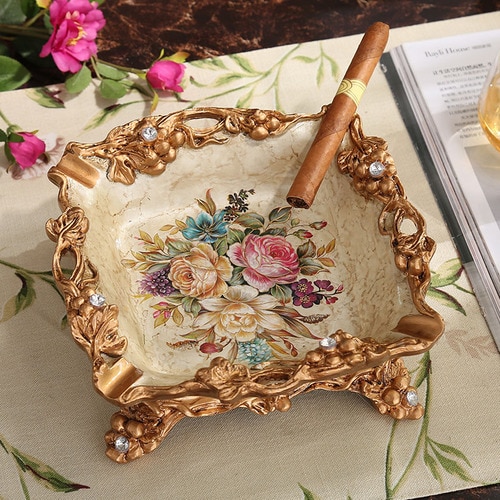
Ashtrays, once considered merely functional items, have evolved into pieces of art and style. Whether you’re a cigar aficionado, a pipe smoker, or someone who enjoys an occasional cigarette, choosing the right can enhance your smoking experience and complement your decor. In this comprehensive guide, we’ll explore the world of ash collectors, covering factors like material, design, size, and maintenance, to help you make an informed choice when selecting the perfect one.
The Significance of Choosing the Right Ashtray
Before we dive into the details of selecting, it’s essential to understand why the choice is significant:
- Functionality: An ashtray’s primary purpose is to safely hold and dispose of ash and cigarette or cigar butts. A well-designed prevents ash from scattering and keeps your smoking area clean.
- Aesthetic Enhancement: Modern are available in a wide range of styles, materials, and designs, making them decorative pieces that can elevate your space’s ambiance.
- Sustainability: Using a designated ashtray helps in responsible disposal, preventing litter and environmental harm caused by discarded cigarette butts.
- Social Comfort: Offering a proper to guests shows thoughtfulness and consideration, ensuring they have a convenient and enjoyable smoking experience.
Now, let’s explore the factors to consider when choosing the perfect collector.
Factors to Consider When Choosing an Ashtray
1. Material
These come in various materials, each with its unique characteristics:
- Glass: Glass are elegant and visually appealing. They are easy to clean and maintain but can be fragile.
- Ceramic: Ceramic are durable and come in various designs and colors. They can be both decorative and functional.
- Metal: Metal ashtrays, such as those made from stainless steel, are sturdy and resistant to damage. They are ideal for outdoor use.
- Wood: Wooden offer a warm and natural look. They may have a classic or rustic appearance, depending on the design.
- Crystal: Crystal are luxurious and can add a touch of sophistication to your smoking area. They are often used for cigar aficionados.
- Silicone: Silicone ashtrays are flexible, easy to clean, and heat-resistant. They are a popular choice for outdoor or travel.
The material you choose should align with your style preferences and intended use. For instance, glass or crystal are suitable for indoor settings, while metal or silicone are great for outdoor use or travel.
2. Design and Style
Ashtrays come in an array of designs, from classic and minimalistic to ornate and artistic. Consider the following aspects when choosing the design and style:
- Shape: These can be round, square, rectangular, or even novelty-shaped. The shape may impact their ease of use and aesthetic appeal.
- Decorative Elements: Some feature decorative elements like patterns, engravings, or logos. Choose a design that resonates with your personal style and preferences.
- Number of Rests: Ashtrays can have multiple rests for cigarettes or cigars, allowing you to accommodate different smoking preferences.
- Size: Consider the size of it in relation to your smoking area and the number of people who will use it. A larger may be needed for gatherings.
3. Indoor or Outdoor Use
Determine where you intend to use. Indoor may prioritize aesthetics, while outdoor should be sturdy, wind-resistant, and easy to clean. Consider with lids or covers for outdoor use to prevent ash from blowing away.
4. Ash Capacity
Check the ashtray’s capacity to ensure it can hold a sufficient amount of ash and discarded cigarette or cigar butts without frequent emptying.
5. Easy Cleaning
Choose that is easy to clean, as regular maintenance is essential to prevent lingering odors and stains. Many modern are dishwasher-safe or have removable components for easy cleaning.
6. Safety Features
For cigar smokers, look for collectors with cigar rests and notches to hold cigars securely. Additionally, consider models with heat-resistant or fireproof materials.
7. Budget
Ashtrays are available at various price points, from budget-friendly options to high-end, luxury pieces. Set a budget that aligns with your preferences and needs, and explore options within that range.
How to Care for Your Ashtray
Once you’ve chosen the perfect, proper care is essential to maintain its appearance and functionality:
- Empty Regularly: Empty the ashtray regularly to prevent it from overflowing. Dispose of cigarette butts and ash responsibly.
- Clean Thoroughly: Clean regularly to remove ash residue and odors. Follow the manufacturer’s cleaning instructions for your specific material.
- Avoid Mixing Materials: If you use different types of ashtrays for different smoking preferences (e.g., cigars and cigarettes), avoid mixing materials to prevent flavor transfer.
- Keep It Dry: Empty and clean it promptly after it gets wet to prevent water damage or staining.
- Store in a Safe Place: Store your ashtray in a safe location to prevent accidental damage or breakage when not in use.
In Conclusion
Choosing the right ashtray is not just about practicality; it’s also about enhancing your smoking experience and adding style to your space. Consider factors such as material, design, size, and ease of cleaning when selecting. Whether you’re a seasoned smoker or someone who enjoys the occasional puff, the perfect can complement your lifestyle and make your smoking moments more enjoyable and refined.

